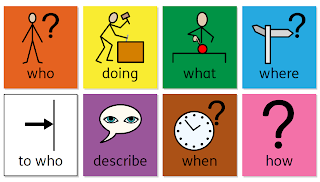Language development is interconnected with aspects like semantics, syntax and pragmatics influencing each other. This post will explore how semantics and pragmatics shape syntactic development. Furthermore, expressive language use enhances vocabulary growth in preschoolers as children build their lexicon by seeking words to express their thoughts.
SEMANTICS
Semantics refers to the meaning behind words and sentences. Its how children understand and use vocabulary to convey ideas. In early development, as children begin to express themselves, they must grasp not just what words sound like but what they mean. For example, children learn the difference between 'mummy', 'run', 'walk'. Semantics play a critical role in syntax development because it helps children understand how words fit together to form logical, meaningful sentences.
The photo above is an example of how semantics and colour are taught hand in hand. Colourful semantics is a visual and structured approach to developing children's sentence building and language skills. It uses colour coded cards as who (orange), doing (yellow), what (green) and where (blue) help children understand sentence structure and meaning. This is originally designed for children with speech and language difficulties. It supports story telling, grammar and vocabulary in an enabling and accessible way.
PRAGMATICS
To expand further on the image above, pragmatics is all about how we use language in real-life situations, its how we choose our words based on what we want to say, who we are talking to and what we think they already know. For example, 'car' means its new information, while 'the car' infers its a subject that has already been talked about.
Pre schoolers don't think about grammar the way adults do. Instead, they learn through experience and by watching others speak. For example if an adult says to a child 'look at dax', the child might guess 'dax' as a thing, probably a noun. Over time, they start to understand how to use language to get their point across.
Overall, pragmatics teaches kids how to use language politely, clearly and effectively in different situations, it also develops naturally through social connection and everyday interactions.
Language Development Differences and Delays
HOW TO APPRAOCH LANGUAGE DELAYS IN CHILDREN WITH AUTISM
In the following video Dr Mary Barbera shares practical tips for supporting language development in children with autism. She emphasizes the importance of avoiding common mistakes when teaching toddlers to talk, especially focusing on early intervention.
Referencing behaviourists like Roger Brown and B.F. Skinner, she stressed the value of understanding how children learn language through interaction and reinforcement. The video is aimed at parents, educators and professionals working with autistic children, offering a clear, research based approach to improving language skills in meaningful and structured ways.
SIMULTANEOUS ACQUISTION
Simultaneous acquisition refers to when a child learns two or more languages at the same time, typically from birth to around age three. This usually occurs in bilingual households where each language is regularly used. According to Genesee (2001) children are capable of developing two distinct language systems without confusion. While bilingual children may have smaller vocabulary in language individually at first, their total vocabulary often matches or exceeds that of monolingual peers over time.
Research by De Houwer (2009) supports this, showing that consistent exposure and interaction in both languages are essential for success. Children benefit most when both languages are used naturally in daily life. This can be done through play, story telling and conversation. Code-switching (switching between languages) is a normal part of development and shows language flexibility, not confusion.
LANGUAGE DEVELOPMENT DELAYS/SYMPTOMS
Language delay means a child isn't meeting typical speech and language milestones. Symptoms include not babbling by 15 months, not speaking by age 2, or not forming short sentences by age 3. Other signs are difficulty following directions, poor pronunciation, trouble putting words into sentences and leaving words out of speaking. The delays can be expressive (trouble speaking), receptive (trouble understanding), or both. This varies based on the child's age and development.
CORRELATION IN HOMELESSNESS AND LANGUAGE DELAYS
Low socioeconomic status (SES) and homelessness can negatively impact children's development. Poverty affects millions, especially those in African American, Latino and Native American populations. SES is shaped by family income, education and occupation, all of which influence what kind of languages children are exposed to. Parents with a better quality education tend to use richer language, while those with SES status have fewer verbal interactions due to stress and material hardships. These challenges can delay language growth.


.png)
.png)


No comments:
Post a Comment